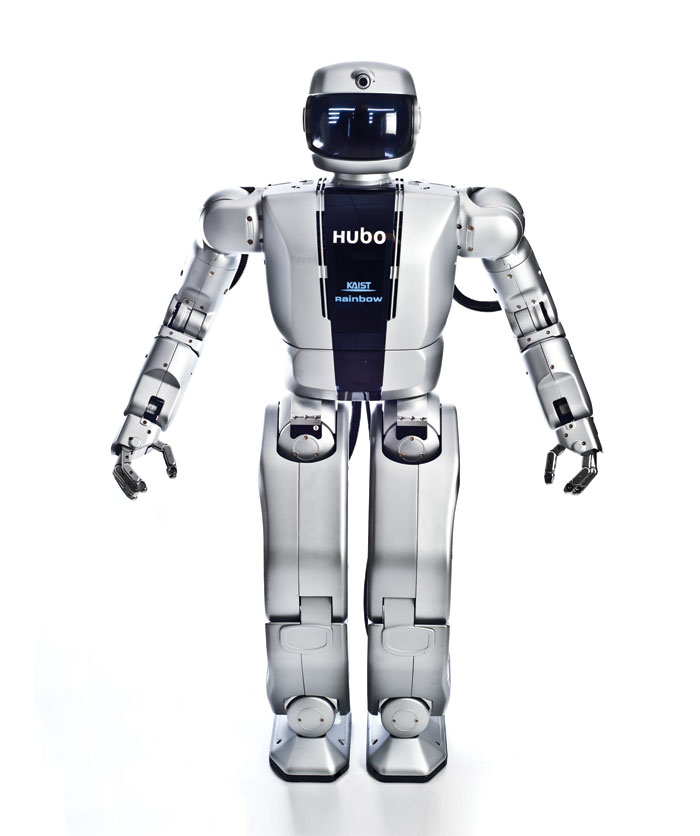Jaemi Hubo has been at Drexel since 2009.
In three years at the College of Engineering, Jaemi has become an active and integral member of the Drexel Autonomous Systems Laboratory (DASL, pronounced “dazzle”), and through countless hours spent in the Music and Entertainment Technology Laboratory (MET-lab), Jaemi has shown rhythmic promise on the dance floor, too. Which is why Jaemi was chosen to perform on stage at the Main Building Auditorium to kick off this year’s Engineers Week festivities in February.
But unlike most others in the College of Engineering, Jaemi isn’t a student. Jaemi’s not even a researcher. Instead, Jaemi is the researched.
Jaemi is a humanoid robot, or “HUBO,” a type of lifelike robot developed by Drexel’s overseas research partner, the Korea Advanced Institute of Science and Technology (KAIST). Standing at 4-feet, 3-inches and weighing about 100 lbs., Jaemi’s design and functionality is a great deal more sophisticated than the average robot. It has a slimmer figure than most, with an aluminum endoskeleton and polycarbonate frame. Its arms can move freely—as can its 10 fingers—and its legs allow it to stride more like an actual human than its robot cousin, Roomba. Oh, and then there’s this: Jaemi is one of seven brothers and sisters (well, to be clear, these robots are gender neutral), and they are all crazy about music.
Since Drexel obtained Jaemi in 2009, KAIST has flown six more identical robots to Drexel in increments, and when the final two robots arrived at Drexel in late February, it marked the largest gathering of HUBOs in robotics history—a feat that is as meaningful as it is impressive.
“By bringing seven robots here and standardizing the research, now everyone is studying on a level playing field,” said Youngmoo Kim, director of the MET-lab, an associate professor of electrical engineering and assistant dean of media technologies in the College of Engineering. “Now, it’s a very apples-to-apples comparison.”
With the accumulation of so many identical robots opening doors for new comparative research, engineers at Drexel are elevating the field robotics to unprecedented ground—and they’re doing so with a little rhythm in their step.
A Hub for HUBOs
Drexel’s partnership with KAIST began in 2008, when mechanical engineering and mechanics department head Paul Oh visited the institute’s HUBO laboratory, where the robots were originally designed and built.
“You can’t buy a humanoid in the U.S. [So Oh thought,] ‘Why don’t we use this opportunity to work with those who do and who are the best in the world with it?,’ which is KAIST and HUBO lab,” Kim said. “We wanted to use it not as just a way to use a really great piece of equipment, but also to learn from that experience on both sides.”
“At KAIST, their primary focus is in mechanical engineering, and they do great design, but there’s not as much focus in software, artificial intelligence or machine learning,” Kim added. “We have a lot more expertise in those areas, so by partnering, we get the best of both worlds.”
Since then, Kim said, Drexel students have traveled to the South Korea for co-ops at KAIST, while KAIST students have also traveled here to study at Drexel. Jaemi’s arrival to University City in 2009 was made possible in part by a five-year, $2 million grant from the National Science Foundation’s Partnership for International and Research Education Program (PIRE).
In August 2010, the NSF awarded a $6 million Major Research Instrumentation (MRI) grant to a group of U.S. institutions led by Drexel to expand upon research with Jaemi and bring the six additional robots in for study.
Robotics researchers from the seven collaborating universities—Massachusetts Institute of Technology, Carnegie Mellon University, Virginia Tech, the University of Southern California, the University of Pennsylvania, Purdue University and Ohio State University—will travel to Drexel to learn how to operate the HUBOs.
“It really is kind of an all-star team we’ll be working with,” Kim said, adding that the group consists of many “world famous roboticists,” maintaining previous academic relationships and also building some new ones.
“We’ll be teaching them how to turn them on, how not to let them fall down, how to calibrate the robot,” Kim said with a laugh. “In some ways, the way you have to deal with these robots is worse than having a baby. It takes a long time before the robot can do something really simple. We’re working to improve that, too, but we’ll be teaching our partners some of the things you only get by working with the robots.”
Eventually, each of the robots will be shipped to the partner institutions to be studied on an individual basis.
But for now, Kim and his colleagues in the MET-lab have plans for the seven-part humanoid dance troupe.
The Aim? To Be More Human
While the HUBOs are sophisticated in the realm of humanoid robots, they still need a fair amount of coddling.
“Humanoids haven’t gotten a lot of attention because there’s not necessarily a direct application for them right on the horizon—that’s what makes it a long-term research problem,” Kim said. “I can tell you a list of 100 things I think humanoids could do—none of which they’ll be able to do in a year, or even five years. But unless we start doing that basic research right now, we’ll never get there.”
Kim said that was the goal of the MRI grant—to create a new research platform by enhancing the robots.
“These robots have a great design, but they’re fairly limited. They can’t see things, they can’t hear, they can’t touch,” Kim said. “We’re going to be putting in new cameras, microphones and tactile sensors, and then build a whole new software architecture so it can take in all that data. Right now, it can’t.”
The possibilities for a sensitive robot are vast, Kim said, but whether the humanoid is dancing to the beat of a tune or just standing still, they’re controlled by computer programs.
“There are computer programs that write music—very, very good music—that could pass for something by Mozart or Bach,” Kim said. “Because we have robots that can build things much faster than we can, maybe we’ll be able to program them to do things creatively to a greater extent.”
He said involvement with the robots has spanned beyond the two labs. Yury Gogotsi with the A.J. Drexel Nanotechnology Institute has helped develop new power systems for the robots, and William Regli, a professor of computer science in the iSchool at Drexel, has helped with the development of capabilities software.
“It really does require a wide variety of skills,” said Kim, who received dual undergraduate and graduate degrees in both engineering and music, as well as a Ph.D. from the MIT Media Lab.
“I think my students would [agree] that a lot of what they learned with working with the robot has not come from the classroom—it’s being able to be hands on and tinker around with the robots,” Kim said.
After first arriving at Drexel, Jaemi spent a lot of time in the DASL lab, where Oh and his colleagues gathered knowledge about the basic functions and quirks of the HUBO design. As MET-lab and DASL researchers began to discuss potential collaborations, Jaemi’s schedule became busier than ever.
“It’s similar to the early days of computers, when there were only a few in the world,” Kim said. “If you were at a university that had one, you would get some time on the computer at, say, 3 in the morning to try to get your work done before someone else gets on at 4:30. It was kind of like that—everyone wanted a turn with Jaemi.”
But with increased collaboration came more interesting projects. A student in the DASL lab was interested in creating a program that would allow Jaemi to watch a conductor and be able to follow the beat—a project that led to developing “music understanding” programs for humanoids.
“It’s a dancing program, essentially,” Kim said. “It hears the music, figures out where the beats are and then can move in time with the beat. The movements are pretty limited right now, and a lot of that has to do with us being afraid to make them do really crazy motions really fast—we have to be really careful with them. It’s about baby steps.”
A Future Undefined
While the robotics research at Drexel garnered accolades and interest from engineers all over the world, Kim said reactions from those outside of the engineering field aren’t always as positive.
“Everybody asks me if robots are going to replace humans in certain jobs, particularly when it comes to the arts. And oh god, I don’t want to see robot musicians or robot dancers,” Kim said.
He said he never thinks of the robots as a way to replace human functions, but rather, as a tool to help further explore current fields.
“I want to see humanoids become useful assistants, to be able to do the things that we can’t do or don’t want to do,” Kim said. “Something as simple as taking out the garbage or doing the dishes, but also the really hazardous things, like dealing with nuclear power plant disasters or space exploration.”
But Kim thinks that humanoids could eventually play a crucial role in expanding fields that traditionally have never used mechanical assistance.
“Robots are tools that could help us understand better what we do, what is unique about being human,” Kim said. “It’s a tool for us to understand what goes into a great musical performance.”
“You can’t say to a piano player, ‘Play that again, but use .1 more Newtons of vertical force.’ No one can do that. I can play it louder, I can play it harder, but I can’t vary myself that precisely,” Kim said. “But a robot can. Just by trying to teach a robot to play like a human, we can learn a lot more about how we do it ourselves as humans.”
While rhythmic humanoids might be a little too reminiscent to the robotic uprisings in “The Terminator” and “I, Robot,” Kim said the fear others have of the future of robotics is a little less literal and more philosophical.
“We hold onto these romantic ideals about what’s human. We used to think a robot would never be able to play chess or Jeopardy better than a human. We were wrong, and I don’t think we need to be afraid of those things,” Kim said. “Just because a calculator can do multiplication faster than I can doesn’t make me feel like I have less self worth. The fact that we as humans can conceive of machines, build them and use them is one of the amazing things about being human.”
“For these HUBOs, that’s still a long ways off. For now, we’re just happy to help them stand up straight and bounce to a beat.”




